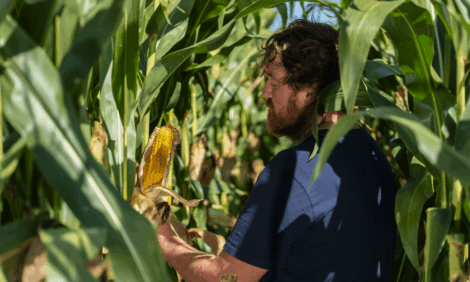



An Introduction into Heat Stress in Dairy Cows
Heat stress sets in at lower temperatures for cattle than humans and as such can lead to great losses in milk yield and foetus development, according to Dr Mike Payne of the Dairy Quality Assurance Programme.Dr Payne says that losses from heat stress need to be understood in order to prompt farmers into acting to prevent problems.
In an article for the California Research Dairy Foundation, he wrote:
What You Need to Know About Heat Stress
- The economic costs of heat stress will vary depending on geographic location and facilities. For California cows with access to shade but not fans or sprinklers, losses are estimated to average $110/cow/year. Losses are higher in cows without access to shade.
- Cows are more sensitive to heat stress then humans, with production losses starting in the mid 70 degrees in moderate humidity and in the low 80’s in low humidly.
- Providing adequate shade may be the most cost-effective heat-stress mitigation available. Addition of sprinklers/soakers or misters/foggers can leverage heat stress reduction provided by shades. Optimal practices will differ from farm to farm, but the majority of western dairies should consider cooling the holding pen and exit lane sprinklers.
- For severe heat stress events, the easiest way to tell if cows require emergency cooling is by counting respirations. If more than 5 out of 10 cows (50 per cent ) have breathing rates exceeding 100 breaths per minute, immediate action should be taken to reduce heat stress.
Economic Costs of Heat Stress in Dairy Cattle
Heat stress will of course vary depending on a farm’s geographic location and facilities. One study estimates that California dairies with minimal heat stress abatement (access to shade, but no fans or sprinklers) lose $110 per cow per year. Losses are higher in cows without access to shade.
Decreased milk production results in large part (but not exclusively) from reduction in Dry Matter Intake (DMI). California dairies with minimal heat stress abatement are estimated to experience average DMI reductions of 320 lb/cow/year, and a concurrent decrease in milk production of about 650 lb/cow/year. Embryos are also susceptible to increased body temperature resulting from heat stress.
Reproduction can suffer even more than milk production with Florida data estimating up to a 53 per cent reduction in conception rates during the summer and into the fall. California operations with minimal heat abatement are estimated to experience in average increase of 12 days open and almost a 1 per cent increase in reproductive culling.
Production losses are not limited just to lactating cows. Heat-stressed dairy cows have been observed to produce 1,000 to 2,000 pounds less milk during the next lactation.
When Does Heat Stress Start in Dairy Cows?
Heat stress results from a combination of factors including ambient heat & humidity, local air movement and absorption of radiant (sunlight) energy.
Cattle are actually more sensitive to heat and humidity then humans. The THI Graphbest way to anticipate whether environmental conditions will have a negative effect on production is to examine a dairy-specific Temperature Humidity Index (THI) chart. Mild heat stress starts to occur at a THI value of about 72, which corresponds to 77°F and a typical Tulare morning humidity of 50 per cent , or at 82°F at a typical Tulare afternoon humidity of 20 per cent .
Even at THI values in this “mild” category, reproductive losses have been documented and milk production can be decreased by approximately 6 lbs/cow/day. Recent studies in high-producing cows suggest that smaller detrimental effects can be at THI values as low as 68. Inexpensive thermometer/hygrometer can be purchased to determine THI values at different locations on the dairy.
How Can I Tell When My Cows Are Heat Stressed?
Certainly cows that are panting with open mouths are in severe heat stress, but at low to moderate levels producers may not observe obvious signs. As described in a review from the University of California, cows do consistently exhibit certain behaviors when trying to mitigate heat.
With rising air temperature and solar radiation cows will increasingly seek shade. Even cows that have deprived of lying for 12 hours will prefer to stand in the shade rather than lie in the sun, sometimes even engaging in aggressive behavior to gain access to it. Either in or out of shade cows will spend as much as 10 per cent more time standing, possibly to increase air flow around their bodies.
Cows will reduce their feed intake, in one study up 5 per cent per day in at 90°F. In a Florida study cows without access to shade ate 19 per cent more at night, but were not able to make up of the decreased feed intake, still eating 13 per cent less then cows with shade. Unshaded cows may also spend 2 to 3 times more time standing around the water trough. The most sensitive and practical measurement of heat stress is respiration rate, which unlike rectal temperature, increases in response to heat load with little or no lag in time.
Normal respiration rates for cattle are about less than 40 breaths per minute.Heat stress app If five cows out of 10 have respiratory rates exceeding 100 breaths per minute immediate action is indicated. The University of Missouri has released a smart phone app that allows beef and dairy producers to merge their cows’ breathing rates with local heat and humidity data to instantly determine heat stress rating and recommendations.



